Miu Miu Croisière 2020 Fashion Show – Original music for the video
Prada Spring/Summer 2020 Menswear Show – Original music for the video
Prada Resort 2020 Fashion show – Original music for the video
Hermès Women’s Autumn-Winter 2019 Collection – Original music for the video
Versace Jeans Couture. Original music for the video
Vogue – June 21st, 2019
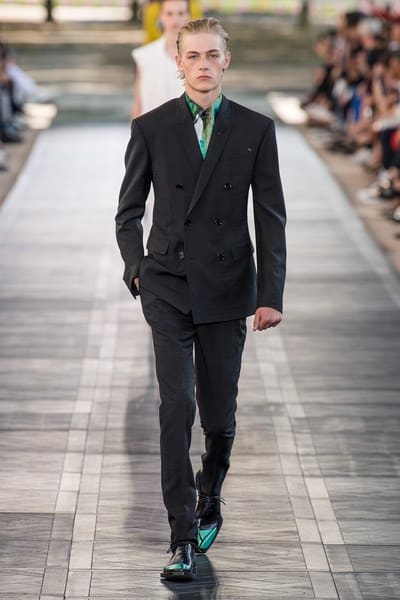
Berluti
by LUKE LEITCH
Gigi Hadid is shaping up as a versatile impact substitute transplanted from the womenswear runways to this season’s menswear. After a warm-up at Versace, she closed Off-White and then this afternoon’s Berluti, where there were plenty of women’s looks on show for an audience that included Ricky Martin and un des fréres Jonas. Berluti is supposed to be LVMH’s solely all-menswear marque, but Kris Van Assche is not down with the same-sex, boarding school vibe. He said: “This is a man’s brand, there is no doubt, but it is also nice to play with seduction…I told Piergiorgio [Del Moro], ‘Bring me the most beautiful girls in the world, because the world needs beauty!’”
Even without Del Moro’s hotties in their ostrich-hazed suiting and painterly printed silk shirting, there was beauty here, plus a nice logic behind it, in the most interesting new fabrication of the collection. This was a precise studding of what resembled small nailheads, applied to an oversized bomber and backpack and then a suit. It was inspired by Van Assche’s observation that while at work in Berluti’s Ferrara factory, the shoemakers often hold nails between their lips while attaching an upper to a sole. Said Van Assche: “It’s just like when people in the atelier put the pins in their mouth…and I was like, this [Ferrara] is really my atelier now. This know-how is usually under the surface…but I wanted to put it on the outside and use it as an embellishment because it is such an inside part of the house.”
Van Assche again mixed tailoring with moto-inspired pieces to evoke the complementary interplay of heritage values and fashion-forwardness he is working to achieve. This was also exemplified in the orange-accent-soled Alessandro shoes and the orange piping on this season’s bag offer. The color of the suiting, some of which included armless jackets and overcoats, or went Bermuda-formal, was a filtered-up, acidified, accentuated interpretation of the palette of dyes used at Berluti to give its footwear that famous rich patina. The house’s scritto motif (the reproduction of a calligraphically expressive 19th-century manuscript transferred to leather)—once hidden away from the Berluti show-sphere but long a popular category among customers for shoes and small leather goods—was transferred to some of that suiting and other coats and suits tailored in leather. One rare-ish all-black look placed a long perforated topcoat against a studded croc briefcase to emanate cashed-up John Wick menace.
Frédéric Sanchez’s breezy soundtrack blended Anne Clark’s Elegy for a Lost Summer with breathy dialogue from Alphaville to build a beguiling sonic parure at this sometimes beautiful but always Berluti-ful show.
Business Of Fashion – June 16h, 2019
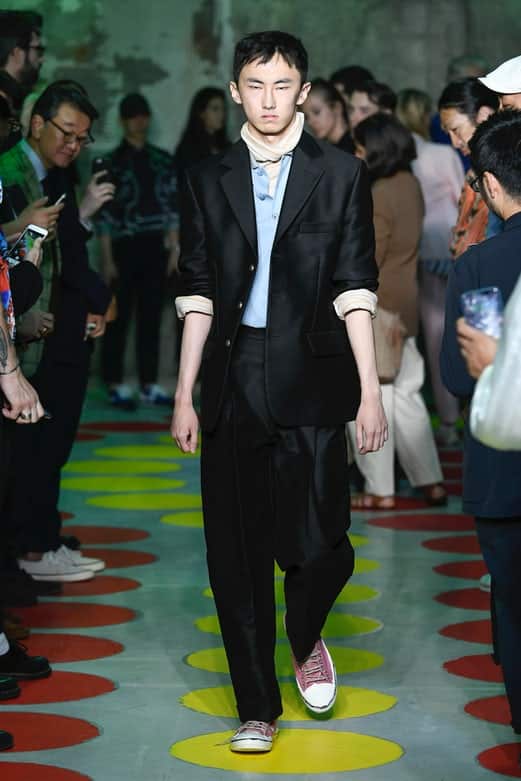
Stitching Opposites Together at Marni
This collection came across as a commercially astute proposal from the designer, who already proved himself a master of prints. Now we get that he’s also a pretty mean tailor.
MILAN, Italy — Each guest at the Marni show on Saturday was assigned a dot to stand on, like a great big game of Twister, because twisting is what Francesco Risso does best. The role he played on Saturday was wedding planner. He imagined his show as the ceremonial union of Truman Capote and Che Guevara, the mixing of two worlds opposed beyond all comprehension: pretty-boy Capote in the famous photo by Henri Cartier-Bresson, guerilla Guevara in the equally iconic image by Alberto Korda. Risso envisaged Capote abandoning high society refinement to embrace “the jungle of radicalism.” In the baldest fashion terms, this could be reduced to a knit polo shirt vs. a camo jacket. Risso gave us that. But there was a deeper philosophical thread: do we live our convictions, or do we just wear them on our sleeves?
Risso came at that question from a couple of angles. He insisted his position was humanistic, not political, but that was disingenuous. How can you not exercise some political sensibility when you’re touching on the issues Risso addressed in his show? For one thing, it was staged under a cloud of aquatically-lit plastic waste, dutifully collected for months by Marni staffers from roadsides, seasides, any sides where heedless humans dump their shit. The audience was like a group of post-apocalyptic Ariels, submerged under the Sargasso Sea of plastic that chokes the mid-Atlantic. Risso claimed it would be transmuted by artist Judith Hopf after the show. One man’s garbage is another man’s art? It took soundtrackist Frederic Sanchez to create an aural co-relative. He ground together the X-Files theme, a voiceover by William Burroughs, “Rock Lobster” by the B-52’s, and a honking sax-driven thrash by UK punk pioneers the Damned to create a densely textured difference.
What makes London such an enduring presence is its variety of voices. Good, bad or indifferent, there is always a polyglot energy. It’s easy to miss that elsewhere, and that is why Risso is such a welcome addition to the Milan calendar. This Marni collection actually came across as a commercially astute proposal from the designer. He already proved himself a master of prints at Prada, his previous gig. The Fauvist-camo prints here were equally masterful. And now we get that he’s also a pretty mean tailor. There were suits to satisfy Risso’s most cautious customers. So, knowing all that, I was happy to sit back and enjoy the scenario that Francesco Risso, wedding planner for the Capote-Guevara nuptials, was ready to offer me. Some of the models wore Che’s beret, but others had picture hats spun from garbage by artist Shalva Nikvashvili. Leigh Bowery would have loved them. The footwear was equally schizophrenic: oxfords vs. scuffs, cobbled together from the Lord Of Chaos knows which bits and pieces.
Half and half – it is Risso’s design ethos, embodied by all the jackets and trousers that stitched opposites together. The political import of such togetherness was inescapable.
20/11/2018
.
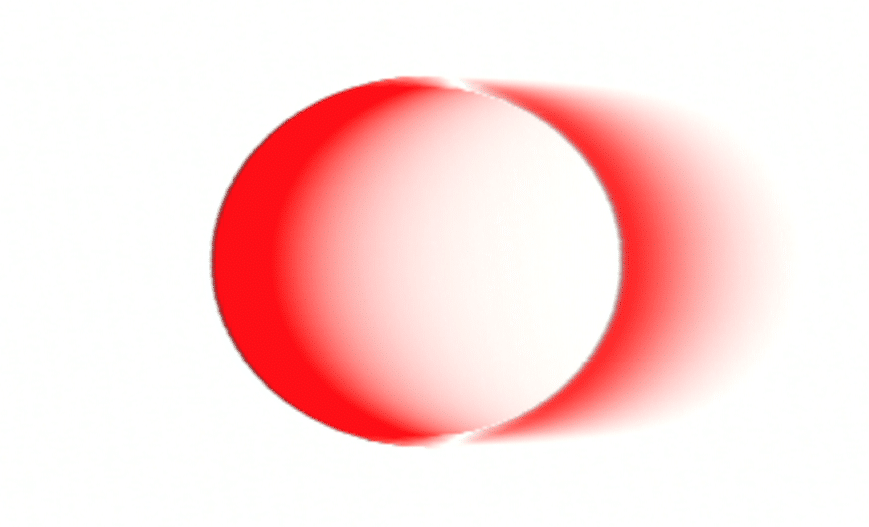
FILM SONORE 26 7.24

.
.
Document – July 31st, 2018
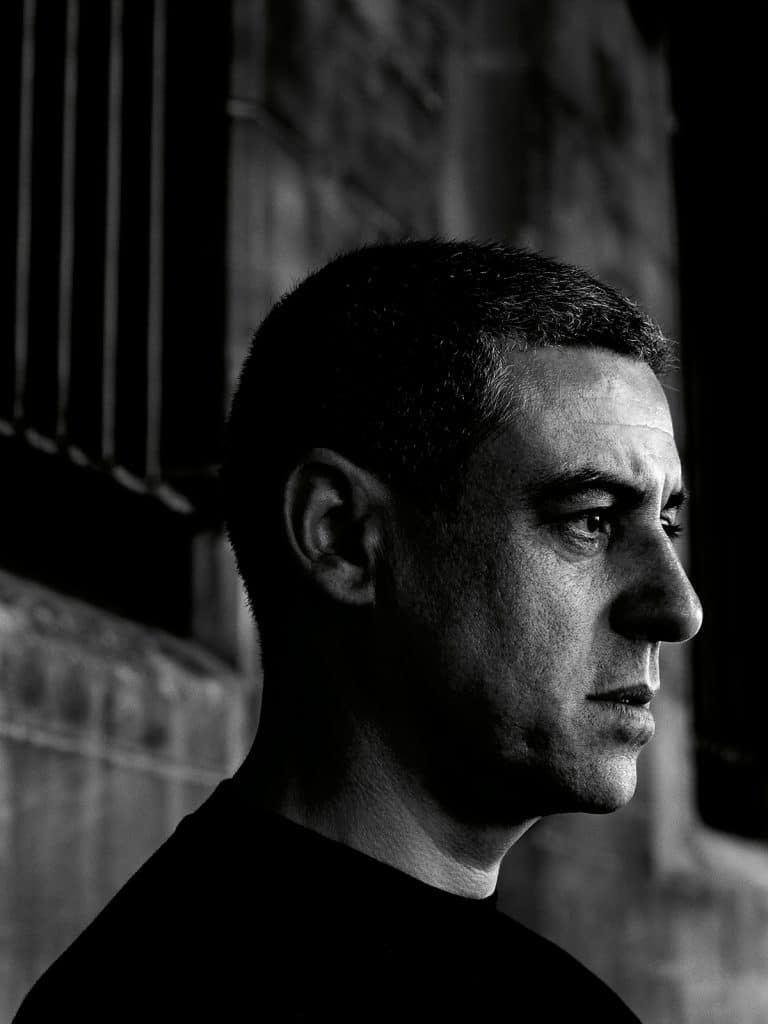
Frédéric Sanchez and Laurie Anderson discuss the relationship between image and sound
Text by
Blake Abbie
Photography by
Willy Vanderperre
Sound designer Frédéric Sanchez and multimedia artist Laurie Anderson discuss the influence of memories, the relationship between image and sound, and Anderson’s new film, “Heart of a Dog” for Document’s Fall/Winter 2015 issue.
During his formative years, Frédéric Sanchez became drawn to the experimental sounds of John Cage and Brian Eno. Meanwhile Laurie Anderson began playing with people’s perceptions of sound in the 70s by electronically manipulating voices and instrumentals. Anderson’s breakthrough piece, “O Superman,” turned her into a household name in the United Kingdom, where it reached number two on the Singles Chart. Martin Margiela met Sanchez by chance in 1988 and gave him the opportunity to create the soundtrack for his next runway show. Since then, Marc Jacobs, Comme des Garçons, Prada, and Givenchy have tapped the sound designer to conceptualize the music for their collections.
The two artists, who are linked through the common medium of sound, blur the lines between the aural and the visual: Anderson through her work across various mediums, and Sanchez by designing the soundtracks for runway shows and art installations. This fall, Anderson returns to directing with the release of Heart of a Dog. Sanchez and Anderson discuss what it takes to be an artist, how memory affects creative output, and the role of sound and aesthetics in storytelling.
Laurie Anderson—Where are you, Frédéric?
Frédéric Sanchez—In Normandy.
Laurie—Beautiful. What’s behind that sheet on your wall?
Frédéric—On the wall? The windows and some trees.
Laurie—You don’t want to see trees?
Frédéric—Well, it’s nighttime now and when I work in the studio, I like to be surrounded in my cavern. [Laughs] So I know your work very well. And I have some experience with it not a long time ago: Last year I worked on the Prada exhibition Art or Sound, where your work was included. I organized all the sound for the exhibition. I work a lot with them.
Laurie—Can I ask you something? What is that snapping sound?
Frédéric—This sound? [Clicking]. It’s just me playing with my pen! It’s making music! [Laughs]. I remember for Prada a long time ago you did [your holographic installation] Dal Vivo. I was very impressed—it’s really something I’m looking at with my work.
Laurie—In what way?
Frédéric—This idea to be with the sound—or with the image—in two places at the same time.
Laurie—Yes. How does that work with you? How do you make that work?
Frédéric—For me, sound has always related to something with memories, like the experience with my grandfather who couldn’t go back to Spain because of Franco[’s dictatorship]. He was always listening to the Spanish radio. He was in Paris, but at the same time he was in Spain with the sound. What I’m doing all the time with the sound is this research of being in different places in a mental way.
Laurie—Can you give me an example of one of your recent pieces that does that?
Frédéric—Three years ago I did a piece Une utile illusion. It was at Galerie Serge le Borgne in Paris. It used the theater technique where I was reading the description of the scene. It was this idea that the person who listens visualizes his own fantasy. I’m really into that; I always research and work with sound. For a long time that has really impressed me with your work.
“What I’m doing all the time with the sound is this research of being in different places in a mental way.”
Laurie—That’s actually why I usually take music out. Let’s say you have a story about a forest, a storm, and a person walking through it. The last thing you want to do is have imagery or sound connected to that. I gradually pare things down and pare things down until there’s more and more room for the person who is listening to enter into that and use their imagination. What you’re saying is that you have a kind of collaboration with people and leave room for their imagination.
Frédéric—Yes. I remember once listening to you [speak] a very long time ago, and you were talking about a story where you were on a plane. I don’t know if it was from one of your pieces or if it was a real story, which is actually nice—if it’s real or unreal. You were on a plane, and there was someone sitting near you who [looked through the window and] said she didn’t know the stars were so close—but it was actually a city. That is something so poetic, these kinds of ideas. I saw your movie Heart of a Dog, and there’s something about that too. It’s not just images; there is something behind that.
Laurie—I think the film also uses a lot of those techniques because it’s just non-stop talking—just blah blah—and I tried to make that your guide through these ideas and then make the visual language very simple, very loop-like, nothing really complicated. I find a lot of times if something isn’t working I have to ask: What’s leading? Is the story leading? Is the picture leading? Is the music leading? If I find that there is too much going on—which I find is usually the case—I take everything else out except what’s leading. How do you tell your story well? You can start using other things in it, but if it starts getting too fancy, just take it out. I’m always editing to make things simpler. With this film, I kept taking music out, I kept taking pictures out, because they got in the way of the story. The story is the driver—it drives everything. I found that I’m less and less a so-called “multimedia artist” and just someone who is interested in story.
Frédéric—For me it’s something that is a very strange thing in Europe. Because you think that you have the “big past,” but for people like me the past has disappeared because of the last war. I’m trying to reconstruct a story through the sound. The sound has this aspect for me.
Laurie—What are you reconstructing?
Frédéric—Something that has been lost, something that has disappeared. People have disappeared; I’m very concerned today by what’s happening in the Middle East, Syria, when you see these people that have to leave their country. My family lived during the Spanish Civil War, and with the sound I’m trying to capture fragments of memories, to reconstruct these fragments. What is very interesting is that I do this work myself, for my personal work, but at the same time what I do for commercial work is not far from that because of its fragments of pictures, fragments of memories that I put together. Twenty five years ago when I started to do this work, I wasn’t thinking about that, but more and more I’ve learned what was inside me and why I was doing this with the sound. For example, 30 years ago when I was 15, I was completely obsessed with music, but I didn’t see myself as a musician. I was doing things with sound, but it was not really music. Then, more and more, something appears like fate, you try to keep making it appear.
I recently listened to Nothing in My Pockets.
Laurie—Oh, you listened to that? [Laughs]. You’re one of three people in the world who heard that! That’s funny. I loved that project for Radio France. But I would never again do an audio diary, because you would have to listen to all of your days over again. It’s not like reading something—you listen through in real time to decide what to do with it. I loved making it and I hated editing it.
Frédéric—Do you think it’s easier to do with images?
“I’ve thought many times about this idea of making records, but it’s not really my thing. My thing is to build an environment with the sound.”
Laurie—I think so because you can move through them more quickly; you can fast-forward and you can’t do that with sound. You just can’t fast-forward and still get an idea of what it is. I love that sound forces you to listen in real time, I love that about it. It’s a very stabilizing thing for me, because you just have to sit back and let it go in clock-time.
Frédéric—When you make music, do you make images at the same time? When I do, I have to create images at the same time. I go take photographs—there’s a real relationship between image and music or sound. I can’t do sound or music without thinking of images.
Laurie—So then how do you put them together?
Frédéric—I don’t put them together; it just either starts with images or it starts with sound. I’m always going to think of an image, and I’ll do it.
Laurie—Wow, that’s so interesting! So do you have a painting studio right behind that curtain?
Frédéric—Well, I live in Le Havre, which is a great place because it’s very industrial. It’s a great place to make images or take photographs, which will always be related to the sound or music that I do. It’s not that at the end there will be both images and sound; it’s probably only going to be sound. But there is always this idea of images somewhere.
Laurie—Are these still images?
Frédéric—They are still images and moving images.
Laurie—Oh, either way. Wow, I don’t think I know anyone who works like that—who works at the same time but doesn’t combine them. It’s very interesting.
Frédéric—It’s very important for me; I’ve always done it. If I create music—because I do a lot of music for shows, in collaboration with people who use mood boards or images—it’s very important to have this relationship between the sound and the visual.
Laurie—I always advise people who are trying to think of what to call themselves to say “multimedia artist,” because it’s totally meaningless. Also I’ve found that the category thing doesn’t help me much at all. To say that I’m a musician , a filmmaker, a painter, or a writer—I do all those things, but my main aim was to avoid the “art police” who come in and say, “What do you think you’re doing writing a novel? You’re a painter!” Frédéric, you probably became an artist for similar reasons to what I did: you want to be free, you want to make something. But guess what, here come all the categories. Generally that has to do with marketing. When I was doing a lot of music, they would say, “OK, what bin are you going to be in? Electro-pop? Experimental electro? Pop electro? Pop-pop?” I didn’t make any distinctions between what I do, and for the longest time nobody ever asked what I wanted to do, so I didn’t decide. I still haven’t decided, so it’s nice to be vague about what you’re doing. I’m preparing for a painting show now in Geneva, September 16 it opens. Which is kind of ridiculous. It’s coming along! I’m used to doing things that I enjoy doing. I don’t really worry about people thinking, “Why painting? It’s just so retro!” So I don’t care. I don’t really care what people think.
Frédéric—We don’t care!
Laurie—I also have a film installation and some music. Probably like you, you don’t really have to put those into categories. You go out and take some photographs, then you’re back in the studio and you’re not worried that one thing is “music” and one is called “photography.” Right?
“For me, sound has always related to something with memories, like the experience with my grandfather who couldn’t go back to Spain because of Franco[’s dictatorship]…What I’m doing all the time with the sound is this research of being in different places in a mental way.”
Frédéric—In America it is true, but in Europe is it not easy to do it because people are really placed into categories. It’s true that I wanted to do something, to create something. Afterwards you don’t care if it’s sound or image—just something. You go above that. Let’s just carry on.
Laurie—Exactly, just carry on and try to make something beautiful, or dark, or disgusting, just something. Just make things!
Frédéric—Yes!
Laurie—You’re sitting in your studio now, is there anything you could play for us that would be easy?
Frédéric—Uh, it’s complicated!
Laurie—No, I know I hate when people ask me that and my answer is like, “Ah, not really!” What are you working on now?
Frédéric—At the moment I’m searching for things.
Laurie—Oh, that’s a nice time! How do you search?
Frédéric—I make sounds; it’s always very free. At the moment I’m writing also.
Laurie—Writing words?
Frédéric—Yes, writing something that is quite autobiographical. All my work, a lot of my personal work, is about memories.
Laurie—Yes, I’m definitely suspicious of memories. Think of how much time you spend in the past and how little you’re spending right this second. I’m always thinking of what you’ll say next or what you just said. For me even on a bigger level, I’m always thinking of different time frames than the one I’m in. I would love to be more connected to what’s going on now, but it’s hard when you’re trying to make something. Because a lot of making is trying to remember something, trying to remember it well with all the intensity that it had. In Heart of a Dog, for me, memory was also sound. It was a sound that I had forgotten, the sound in a hospital when I was a kid. I only remembered it through telling a story about myself. I remembered how much fear there was in that situation, and that wasn’t part of my story because it was too hard to tell. At that point, they just moved all the kids into the same place. So if you’re a kid and you’re afraid and all these kids around you are dying, you don’t really know what that is, and nobody really talks about it. Nobody in my family visited me, because they were too busy. So it was very, very scary for me. It was too scary to remember it correctly, so I remembered it in a different way—called repression, as the psychiatrists say. So in the film I tried to represent that sound through silence. There is a section right after that where there is no sound. That, in a movie theatre, is scary; it’s very scary when sound is turned off. It’s different on your computer because you’re surrounded by ambient sound, but when you’re in an immersive sound situation and the sound disappears you think: “Something has happened, something is wrong.” The hairs go up on the back of your neck because you’re thinking, “Did the projector break?” The image is still there but there is no sound. And it’s a very primitive feeling of dread in a way—something broke. I think for me also sound is very connected to true and false memories.
Frédéric—When are you going to show the movie?
Laurie—It will be in the cinema at the end of the month, this August. It will go to festivals. Actually for three or four months it will be out and around and then released in movie theatres.
I like that you’re in a moment of just looking around. I think that’s the greatest moment. The freedom to play different sounds and think, “What is it? Is it the beginning of an opera? An installation?” How do you think of imagining what a sound will become? Do you think something might be a beautiful symphony? Or a static sound under a bridge in a park? Or a pop song?
Frédéric—It’s installations, always in a place, in a room. This is important for me. I’ve thought many times about this idea of making records, but it’s not really my thing. My thing is to build an environment with the sound. The next one is a show I’m doing at the National Library here in Paris. It’s going to be a sound installation.
Laurie—What kinds of sounds will be in the library?
Frédéric—The library has a huge collection of very old recordings from the beginning of the 20th century. It’s called the Museum of the Voice.
Laurie—Beautiful.
Frédéric—It’s really beautiful. They’ve asked me to do something with that, to create an environment.
Laurie—What an incredible project!
Frédéric—Something I had done in the past was using this recording of the Guillaume Apollinaire [reading his poem] Le Voyageur (The Traveler). The project is about this idea of the traveler and all the voices in the library. I had this idea of the library scene in Wings of Desire by Wim Wenders, all the voices.
Laurie—You know, when he was mixing that movie in Cannes he sent me a message saying, “Can you send me some angel fragments? I’m mixing my movie.” I didn’t ask him, “What’s an angel fragment?” I just sent him a little selection of things that I thought sounded like angel fragments. I said, “Check these out and if they work I’ll record them and get you a good copy of them.” I sent him a cassette and he just used the cassette! But the way he used it was so fantastic: he used it as headphone leakage in the scene with a guy on the train.
Frédéric—It was beautiful.
Laurie—You know, he’s so smart about the use of music and all the different ways it can sound. He’s not a purist in terms of the way the soundtrack lays under the dialogue in a movie. He has sound coming from all sorts of sources and distortions and places—it’s so moving. Instead of having the big, monolithic soundtrack where it’s just about emotional manipulation and it’s like, “Here’s how you feel about this house, here’s how you feel about this character.” You’re helpless. He doesn’t do that with music or sound, and I think he’s one of the geniuses that way. I love hearing how he treats and filters music. I’m very excited about the Museum of Voices, when is that happening?
Frédéric—It’s going to be this November.
Laurie—Coming right up! I’m likely going to be there around that time, so I’ll come check it out! I’ll see you then.
Frédéric—Yes, please do!
Document – May 8th, 2018

How Prada’s music producer Frédéric Sanchez landed on 90s classics for their 2019 Resort show
Text by
Megan Wray Schertler
The music producer crafted a show soundtrack inspired by timelessness and Daft Punk for Prada’s 2019 Resort show.
As one of the biggest show music producers in fashion, Frédéric Sanchez has created show music pieces for the biggest names in the fashion industry since his first live show gig for Maison Martin Margiela show in 1988. Ahead of the first Prada’s 2019 Cruise show in New York—its first in the city after a 20-year absence—Miuccia Prada tapped Sanchez, a long-time collaborator with the designer to provide a soundscape for the show that was unquestionably 90s—think lots of Daft Punk and R.E.M. Document spoke with Sanchez backstage at the designer’s headquarters, a former piano factory on West 52nd Street, following the show’s noisy melange of technical fabrics, loud prints, and graphic logos placed front and center.
Document—How did you land on this particular musical direction for the show?
Frederic—When Mrs. Prada and I started talking about the collection, we were feeling nostalgic for certain things that we did in the 90s. There was also a hint of the psychedelic. This season the word we kept returning to was “timeless” and the idea of being without any references, which is kind of completely the opposite of what I was saying five minutes ago. That’s why we used a few pieces of music that felt very iconic from that time, like the first record from the French band Daft Punk that came out around that time. We both said, “This is so iconic that it does not feel old.”
Document—What was the specific mix?
Frederic—I used two specific songs from that record [1997’s Homework], but I kept only the rhythm, and we remixed in a way that makes it even more contemporary. Then, we had three songs mixed with this a track from the film Donnie Darko, Gary Jules’s ‘Mad World’, and then the song ‘Wake Up’ from a band called Mad Season. It’s two musicians, one from a band called Alice in Chains from the grunge era, and another one from Pearl Jam. Then, we used an R.E.M. song.
“I think it’s very difficult to look at what is happening in the current moment because there’s so too much of everything. I think the only way to create something that resonates is to go deeply into yourself.”
Document—What was the R.E.M. song that you used?
Frederic—The R.E.M. song is The One I Love. It’s from an unplugged record.
Document—A total classic.
Frederic—Yes! So very classic songs and very romantic in a way. The obvious thing would have been to use the electronic sounds from Daft Punk to open the show, but we used the song from Donnie Darko, which is a very, very romantic thing. Then, suddenly, you have that clash with the very strong electronic beat coming in. So, it’s really these two things that are clashing through the whole show.
Document—It’s impossible to tell whether something will stand the test time without substantial distance. R.E.M. is a really great example of that. I feel like they hit the peak of their pop-stardom in the 90s then kind of fell out of favor as the decade came to a close. But, I think a lot of their music sounds really fresh now when you revisit it.
Frederic—Yes, yes. And also because the personality of the person that made them, you know? When you think about Michael Stipe or Kurt Cobain, they have become icons. Icons don’t die. [Laughs]
Document—I think they start to mean different things to different generations.
Frederic—I think it’s very difficult to look at what is happening in the current moment because there’s so too much of everything. I think the only way to create something that resonates is to go deeply into yourself.
Document—To let intuition guide you.
Frederic—Exactly, yes. It makes it personal and sensitive.
Document—Mrs. Prada must be a fantastic person to collaborate with in that case. I feel like intuition is very much a tool she uses to navigate each season.
Frederic—Completely. It’s fantastic because she pushes you to go deeply into what you want to create and what you think.
Document—How early do you start working on the soundtracks for the shows?
Frederic—I work for Prada all year long, so I am researching all the time for them, but I called them maybe two weeks ago to discuss music for this show. The process really starts the moment when they put the clothes together and do the fittings, so like a week before the show. I arrived in New York on the Monday before the show and was there everyday. When making the soundtrack for the live event, I always like to use existing music because it’s almost like the effect of perfume. I can transfer emotion through references. There’s a sort of romanticism and poetry to the songs. The rhythm tells you something about modern things, architecture—the modern world as we know it.
Fashion Network – February 24th, 2019
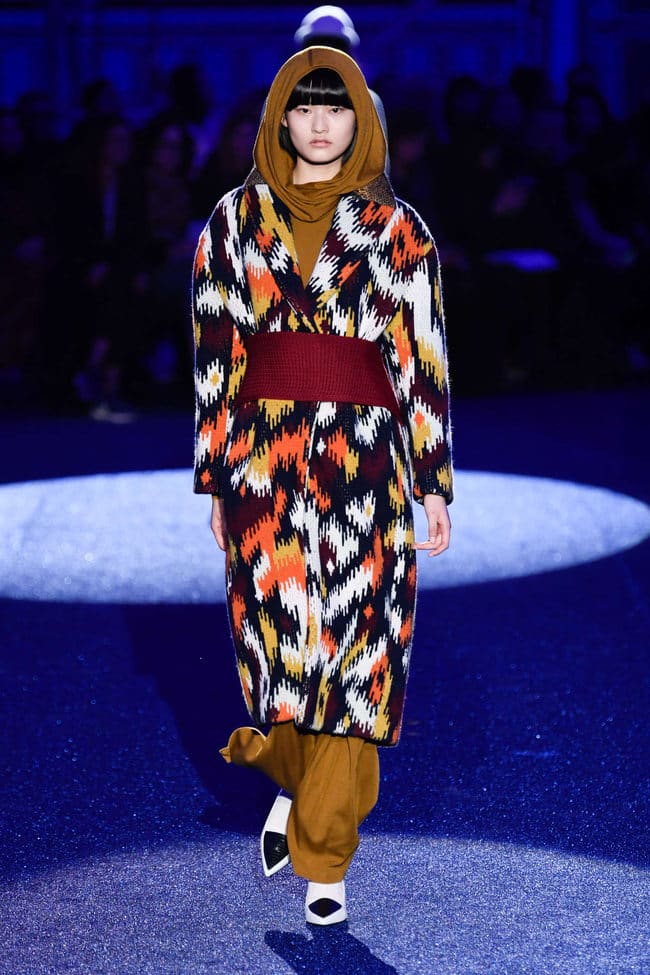
Missoni : classe, net et haut en couleur
Par Godfrey Deeny
La science des couleurs, dont une étude approfondie pour l’une d’entre elles, était au cœur de la dernière collection fluide, aux formes allongées, et du défilé organisé par Missoni ce samedi soir à Milan.
La directrice de la création, Angela Missoni, a choisi un nouvel espace d’exposition – un palais des glaces géant construit dans les années 1920 – et baigné la structure de style Liberty de lumière bleue éclatante.
« On pénètre directement dans un écran bleu… fait pour téléporter les personnages à travers les époques et les lieux, en un clin d’œil », expliquait le programme. L’invitation annonçait les intentions d’Angela : un foulard en soie dans une débauche chromatique de couleurs marbrées, avec un leitmotiv bleu.
Le résultat était une silhouette allongée et gracieuse, avec des variantes sous forme de charmantes vestes en jacquard portées avec des capuchons et des hijabs. Mais les silhouettes les plus spectaculaires étaient ces manteaux en jacquard aux motifs floraux abstraits, portés avec un tchador funky. Pour le soir, des combinaisons et des dos nus étincelants, en lamé bleu saphir.
C’était le dernier d’une série de défilés mixtes à Milan, avec notamment cette saison Gucci, Bottega Veneta, Giorgio Armani et Salvatore Ferragamo. Pas étonnant que la saison masculine de Milan raccourcisse sans cesse !
Pour les hommes, Angela Missoni a imaginé des cardigans en jacquard plein de goût et quelques brillantes vestes en patchwork irrégulier. Des looks classieux pour week-end d’automne frisquet, ce qui se fait de mieux en matière de chic décontracté. Et pour la ville, pourquoi pas adopter ces pardessus dégradés de gentlemen, bleu vif aux épaules puis s’estompant en bleu pacifique sous la taille ?
« Une ligne de conduite claire et pure. Rien de superflu, que du pur Missoni », insistait en coulisses une Angela Missoni tout sourire.
Tous les mannequins étaient baignés de bleu, tandis que la spectaculaire bande-son comprenait le tube culte de Kevin Ayers, « Two goes into Four ». Une chanson appropriée pour une marque qui monte clairement en puissance depuis juin dernier, quand le groupe d’investissement italien FSI a acheté 41 % des parts de Missoni pour 70 millions d’euros.
Le nouveau financeur contribue à développer l’impact de Missoni en matière de distribution, avec une demi-douzaine de boutiques supplémentaires cette année, de Miami aux pays du Golfe, et surtout un magasin amiral sur Madison Avenue.
Vogue – February 21st, 2019
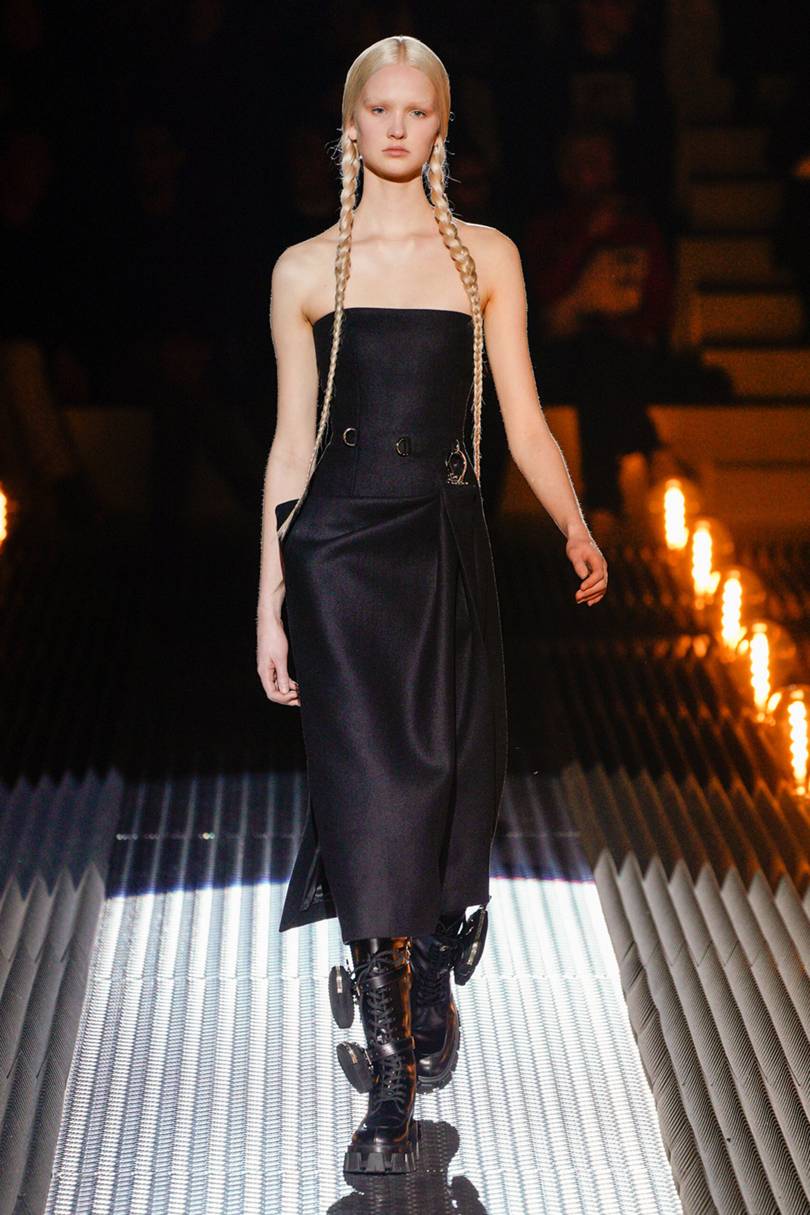
Prada
It’s a heavy season in Milan. With the monumental news of Karl Lagerfeld’s death on Tuesday, fashion descended upon the Italian fashion capital in the wake of accusations made against Gucci and Prada that products of theirs referenced blackface. In Prada’s case it was a keyring in the image of a monkey with red lips. After strongly denying any such intention when the news broke in December, last week the house further announced the creation of a diversity council chaired by Theaster Gates and Ava DuVernay. Going forward, the artist and the film-maker will be in dialogue with Prada, making sure the company’s merchandise never evokes any such reference again. Gucci has taken similar action, but the weight of these incidents has transformed the industry in record time. And while it will unquestionably shape a better future for fashion, it currently leaves a thick cloud of disenchantment around the Milanese shows.
“Fear is around us. Danger and fear,” Miuccia Prada said after her show, which expanded the horror themes she investigated in her menswear collection last month. She continued her studies in interpretations of fear, from the terrifying – unadorned military tunics, combat uniforms and minimalism – to comical graphics like Frankenstein’s monster lifted from what she called “trashy horror movies”. “You have to make light because it’s still a fashion show,” the designer shrugged, also name-checking her fuzzy faux fur neon backpacks on that note. Mrs Prada said she added a sense of romance in all the flowers and lace that prettified an otherwise austere collection, seeking to battle the mood of fear with “a source of good”. “Each girl was a piece of a love story of my vision of love,” she explained.
The good with the evil? Frédéric Sanchez sampled an instrumental version of Lady Gaga’s ‘Bad Romance’ on an exceptionally brilliant soundtrack that deserved its own interpretive thesis. From the thought-provoking titles of songs like Marilyn Manson’s cover of ‘I Put A Spell On You’ and Qual’s ‘Existential Nihilism’, to expressive horror themes like Tales From the Crypt and the opening tune from The X-Files, he very nearly – but not quite – outdid his own soundtrack from January’s Prada men’s show, which featured The Addams Family symphony. Wednesday Addams made several appearances in Thursday’s collection, evoking the familiar idea of nihilistic teenagers – or anti-social adults – who unsubscribe from a world that they fear; in which they feel misinterpreted and mistreated. “Frankenstein’s monster was rejected, but even he was loved,” Mrs Prada reflected, perhaps forgetting how that story ended.
But for all the romance and gallows humour she imbued her collection with in huge flower and monster motifs on silk or knitted dresses and leather skirts – sure to sell up a storm come autumn – the sentiment was undeniably ominous. Asked what it is she fears so much, the designer talked about wars. “Any kind around us. Vile parties and the vile situation in Europe. Strong contrasts growing and growing. In another siècle there would already be a war. I really fear that.” It’s not an uncommon theory: around every turn of the century, a few years before or after the clock strikes twelve, radical revolutions and wars have changed the world with tumultuous impact. What that means in the digital age is anyone’s guess, but the dialogue Mrs Prada has now initiated within her own company is a sensible precaution.
“We work for rich people. We do rich clothes,” she said on the topic of designers and their social conscience. “But somehow fashion is very relevant. There is a request for fashion to talk about political subjects. But to approach political subjects in a world of pleasant things is very difficult. You’ll be criticised. The work is serious but it’s also for pleasure.” Paradoxically – or perhaps not at all – more than her light-hearted horror graphics and romantic floral motifs, it was Prada’s decadent cocktails dresses, glamorous draping and austere tailoring and military garb that felt most desirable for the moment we currently live in.
Business Of Fashion – January 23, 2019
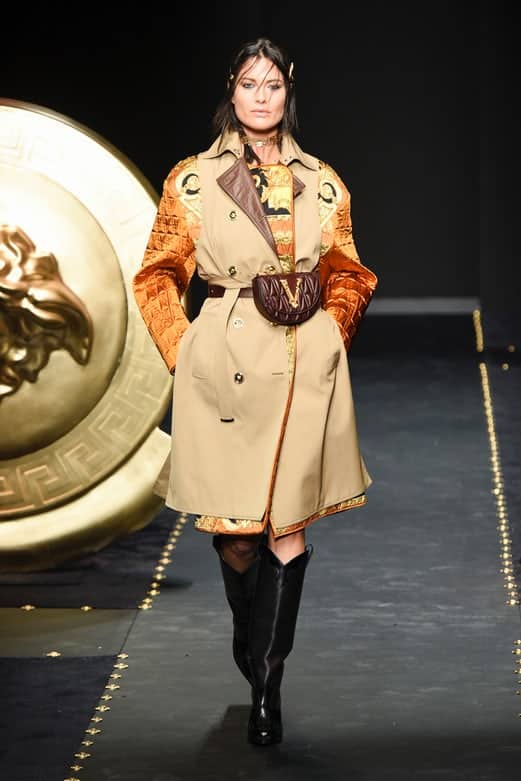
Versace Goes Big
The strength of Donatella’s new work is the way she embraces it, with love and fearlessness and the same dry wit with which she deals with all the tricky propositions in her life.
By Tim Blanks.
MILAN, Italy — You know the expression, “Go big, or go home”? And that other one: “You can’t go home again”? Donatella Versace is the kind of woman who wants it all. On Friday, she went big AND went home. Going back to her roots, and blowing them skyhigh. As skyhigh as the gigantic safety pin that dominated her catwalk. (The invitation was a box of safety pins.) How good did THAT look when DV posed in front of it? “We’re living on Instagram,” she murmured during a press preview earlier in the day.
Social media-savvy she may be, but Donatella is also a faithful believer in the physicality of fashion. Meaning, the show’s the thing. Frederic Sanchez, back in the fold after some years elsewhere, made a visceral soundtrack which mashed up Nirvana and electronics, the aural counterpart of Donatella’s luxury vs. grunge concept. But she herself has become the fashion equivalent of a DJ, remixing elements of her past to make new shapes the way a musician creates new sounds. It’s enough to make you wonder why more designers haven’t taken a leaf from her book, had a long, hard look at past triumphs and given them a contemporary spin.
It worked here because it felt unhinged. Like the men’s show in January, there were a thousand pieces in play: fabrics, textures, colours fighting each other in gorgeous chaos, but styled into a coherent, perversely irresistible proposal. Well, maybe not quite as coherent as it was in January, but even that seemed like it might actually have been the point. There was sheer deliciousness in a tattered lime green cashmere sweater bunched with jeweled safetypins, laid over a python-printed pencil skirt with a suggestion of red lace at the waist and a faux fox stole gripping Fran Summers’ throat (there must be a celestial fashion consensus that each season dictates how certain models get the best outfits in the shows they walk in – I would say Fran and Adut Akech are the anointed ones for Autumn 2019).
There was something exquisitely lurid about such a look, and that same quality infused the whole collection: satin slip dresses with fluoro lace stockings, or without them, with harnesses instead (like Kiki Willems’s tiny little chartreuse situation); those same harnesses restraining earnest tweeds; big fat coats hiding a multitude of sins (this was a collection for SINNERS); and Adut’s glorious gold mesh column with some odd red lace underpinnings.
Donatella literalised her back pages with a t-shirt that reproduced Richard Avedon’s 1995 ad campaign for the fragrance BLONDE. No prizes for guessing who the blonde in the ad was. She also reproduced the perfume’s Lalique bottle as a print. You can’t go home again? Not true. You can’t escape your past. The strength of Donatella’s new work is the way she embraces it, with love and fearlessness and the same dry wit with which she deals with all the tricky propositions in her life. It’s a very convincing proposition, made even more so by the casual catwalk ambulation of Stephanie Seymour at show’s end, like Donatella saying, “Those women existed and here is one of them, right here, right now, still kickin’.”
Business Of Fashion – January 22nd, 2019
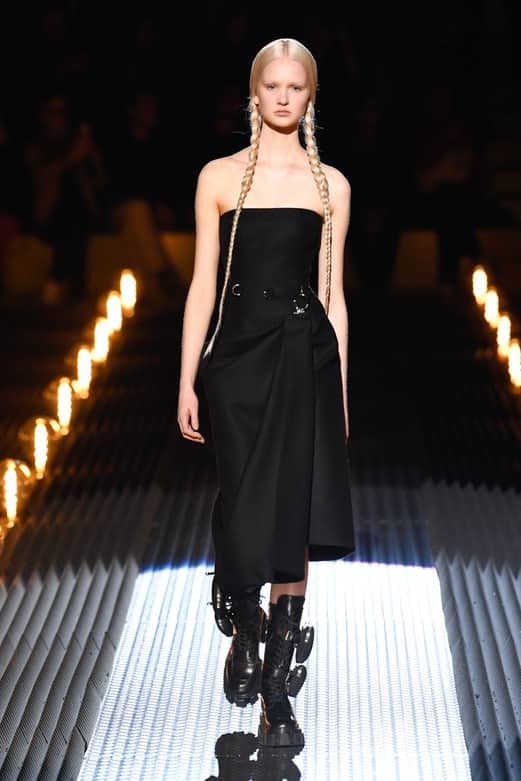
Monsters Reappear at Prada
It might have been one of Miuccia Prada’s most curiously uncompromising collections. She has always twisted tropes to animate her collections, but there’s more urgency now.
By Tim Blanks.
MILAN, Italy — Miuccia Prada loves love, but she hadn’t finished saying what she thought about it in the men’s collection she showed in January. Modern romance is a movable but fiercely compromised feast, so Miuccia used her new women’s collection to expand on her conflicted thoughts. There’s fear in the air, monsters stalk the planet. Love is all we need, but it’s not enough, is it?
Maybe consistency will convince. Miuccia rolled over the same window-dressing that she’d used in January: the same foam-rubber floor with the filament lab lighting, the same safety-pinned heart, the same Hellmouth remakes of classic songs on the soundtrack (this time, Marilyn Manson’s “I Put a Spell on You” and a Laibach revision of “My Favourite Things” that could send you screaming to the nearest sanctuary). And Dr Frankenstein’s monster reappeared, but this time Miuccia united him with his bride. The He&She of Horror. The Adam&Eve of ManMade Man.
Miuccia felt that the topicality of reconstructed humans in an age where we are blindly walking into subjugation to AI was worthy of comment. She’s frightened. So fear was a creative impetus in her collection. She mentioned “a very real fear of wars so near” when she was talking about the military aspect of her collection. She shod her models for conflict. And then she dressed Gigi Hadid in a particularly shapely hybrid of an MA-1 and field jacket which she paired with a delicate black lace skirt. Such a contrary combination weaponised womanhood in a way that made this collection a TKO. It was amplified in the way that classic menswear fabrics – tweed, herringbone – were transmogrified into classic femme fatale shapes. Like Binx Walton, tweed sheath limned to her body, portrait neckline recklessly askew. An image more potent than the repurposed combat-wear that surrounded it.
Miuccia Prada has always twisted tropes to animate her collections. Think of a cliché, flip it or burn it to ash. But there’s more urgency now. In a grisly ironic flourish, “Someday My Prince Will Come” from Disney’s “Snow White” floated across the soundtrack. Face it, he ain’t comin’. So Miuccia’s women created an apocalyptic beauty for themselves. Something ruched, something draped, and maybe a little lacquered lace. But fucked-up. There were flowers, but they might have been borrowed from a graveyard. There were leather skirts printed with tulips and roses but they felt like fetish gear (the women wearing these particular items were fiercesomely maîtresse-like, so someone agrees with me!).
It might have been one of Miuccia’s most curiously uncompromising collections, but she’s a past mistress at anticipating moods, so timeliness ameliorates in-your-face. When she was a student, she’d man the barricades in vintage Saint Laurent. Now she’s making clothes for her modern equivalents to do just the same. Vintage Prada, in the here and now.
Business Of Fashion – January 13th, 2019
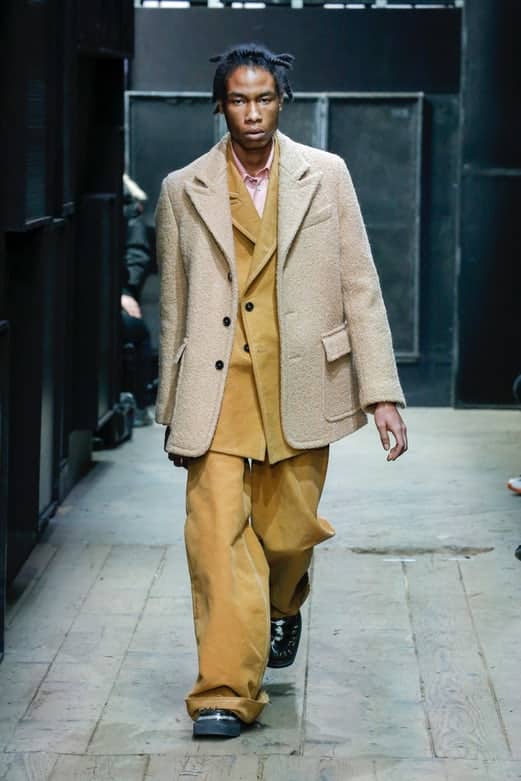
Marni’s Great Culture Clash
Francesco Risso’s collection — a seeming confrontation between youth and what he called ‘the puppet masters’ — laced his parody of power-dressing with psychedelia and subversion.
By Tim Blanks.
MILAN, Italy — The eerie sarcophagus of speakers that enveloped the Marni venue on Saturday afternoon bled a crackly antique recording of Debussy’s “Prélude à l’après-midi d’un faune” while Francesco Risso’s first models stepped out onto the catwalk. That music will forever be the soundtrack of Nijinsky’s most transgressive ballet, a record of the moment when a radical new vision slammed into the old world with such seismic force that the culture changed. Maybe it wasn’t such a stretch to imagine Risso hoping for the same thing with his collection.
He had in his mind that there was “an elephant in the room,” which he insisted no one was talking about. As tricky as it was to winkle out the core of what Risso meant, he seemed to be talking about the power of youth, cruel but fearless in its innocence, and yet denied by those he called “the puppet masters.” Risso’s collection could therefore be cast as a confrontation between two tribes, those with power, those without. “The undefinable aliens mingle with the indefensible weirdos,” was a stand-out line from Marni’s typically dense but teasingly allusive manifesto for the season.
Risso interwove his parody of power-dressing — huge overcoats, exaggerated multi-tasselled loafers, “an army of conservative suits blown up” (his words) — with psychedelic pyjamas, manga shirts, paw-like gloves, and visual references to Bruno Bozzetto, the Italian animator whose subversive work qualified him as the anti-Disney. Perhaps you could construe the result as the most classic confrontation of Western civilisation, Apollo vs. Dionysus, with the battlefield as a single outfit lifted from a collection of menswear by Marni. That is one crazy elephant in any room.
For me, there was one particular piece that captured Risso’s uniquely screwy fashion vision. It was a diamond-patterned sweater, tattered in such a way it looked like an animal pattern was fighting to emerge, the beast within, perhaps. What really lies beneath? If humankind could ever answer that question, we might be able to free ourselves from the enduring quandary of our savagely flawed existence.
Fashion Network – January 14th, 2019
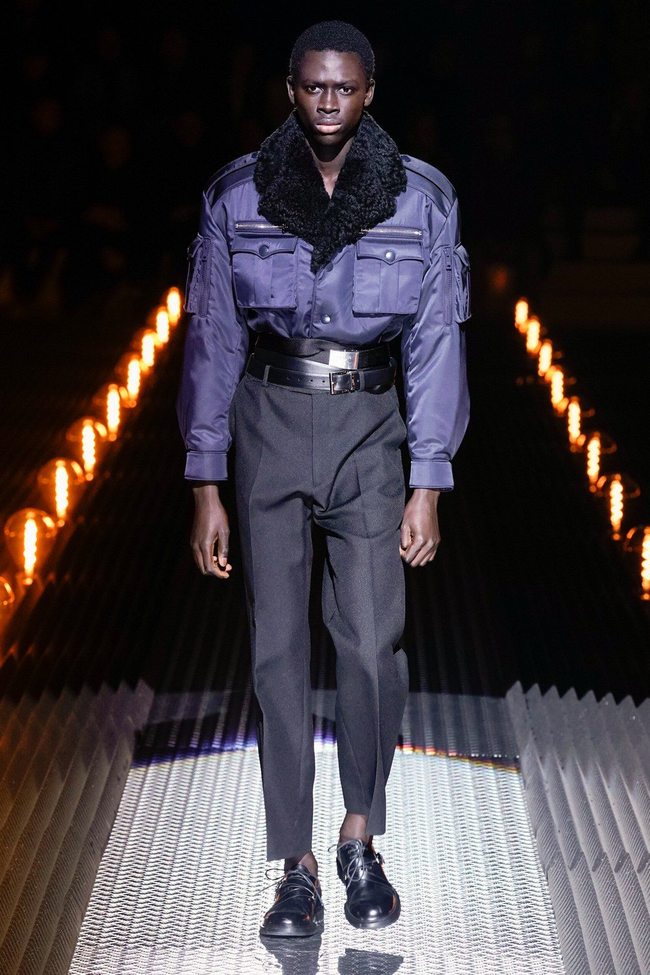
Merveilleux bal des monstres chez Prada
Par Godfrey Deeny
Voilà ce qui s’appelle un grand défilé de mode. La dernière démonstration de style de Miuccia Prada était présentée dimanche soir dans un Milan glacial : un défilé mixte aux multiples références, des masses, des marges au bal des monstres.
La principale penseuse de la mode italienne, la Signora Prada, convoquait brillamment l’ADN Prada pour l’hiver 2019, tout en délivrant un subtil message politique. Et dans une période troublée partout en Europe, elle nous rappelait que la mode joue elle aussi un rôle, même s’il est mineur, en offrant un résumé visuel des angoisses propres à chaque époque.
D’autre part, la mise en scène était d’un talent consommé : un hall en béton récemment achevé au sein de la Fondazione Prada, habillé de gradins vertigineux et d’un podium oblongue géant, composé de panneaux d’isolation acoustique en mousse noire – qui se sont révélés tout à fait confortables pour s’asseoir, en vrai. Au milieu, le podium était illuminé par des spots et des ampoules géantes de style rétro.
« Je pensais à la masse du plus grand nombre, ceux qui ne sont pas riches, qui ont du mal à payer les factures et à survivre, à la manière dont ils vivent et s’habillent », a révélé Miuccia dans la foulée du défilé, après avoir posé devant un nouveau logo Prada dans la même matière isolante. Un logo sur un mur jaune vif, la dernière révolte française en date, celle des gilets jaunes, infiltrant Milan cette saison. On avait déjà repéré des jaunes similaires ce week-end chez des marques aussi différentes que Bottega Veneta et Versace.
Sur le podium, les hommes défilaient en costumes sobres : pantalons taillés au-dessus de la cheville, vestes flatteuses et manteaux serrés à la cheville par des ceintures doubles. Opéraïste et très élégant. Son autre grande idée, c’était ces sahariennes magiques bleu nuit ou noir d’encre, réinventées en doudounes et ornées de poches sur les manches. Elles déclencheront à coup sûr une tendance majeure dans le monde entier.
Les premières silhouettes féminines étaient aussi d’une simplicité trompeuse, comme ces petites robes noires remarquablement bien coupées, avec des hauts façon soutien-gorge dégageant les épaules. Quand soudain, Miuccia a passé deux vitesses d’un coup, injectant une dose ludique de style film d’horreur : comme ces imprimés représentant le visage de Frankenstein et d’étranges fleurs déformées utilisés sur de puissantes jupes au genou, associées à des hauts en mohair rose et des bustiers composés du tissu signature de Prada, un nylon noir soyeux… bien sûr ! Et si les jupes plissées en coton dense, rebrodées de cristaux, avaient une allure folle sur Kaia Gerber et Gigi Hadid, elles iront également comme un gant à des femmes d’affaires deux fois plus âgées. En fin de compte, l’une des plus grandes forces de Miuccia Prada en tant que créatrice, c’est que ses vêtements collent magnifiquement aux femmes à de multiples étapes de leur vie.
Emmenant tout le toutim vers de nouveaux sommets, il y a eu une formidable série d’accessoires : comme ces nouveaux sacs à dos de taille intermédiaire, avec des bandoulières et des bretelles étroites, ou encore de super chaussures et bottines façon pneu de tracteur.
Une bande-son puissante de Frédéric Sanchez envoyait du Marilyn Manson, du Tuxedomoon et la bande originale du Rocky Horror Picture Show.
« Je voulais refléter mon sentiment sur notre époque. Même si, puisque c’est de la mode que nous faisons, il fallait que tout ça soit optimiste et amusant, ce à quoi le spectacle horrifique a contribué », riait Miuccia Prada, vêtue d’une très belle redingote en daim couleur tabac, avant d’être submergée par les fans. Ils mouraient tous d’envie de la prendre en photo devant ce fameux mur jaune.
Business Of Fashion – January 13th, 2019

Versace’s Mysteries of Manhood
The collection brooded on the scattergun codes of modern masculinity with an orgy of quite gorgeous separates likely to hit their target.
By Tim Blanks. MILAN, Italy —Donatella Versace knows her divas. Her brief to soundtrackist Frederic Sanchez for her new men’s show was to the point: Ru Paul and opera. He gave her Supermodel and Maria Callas. And if that’s where Donatella thought a boy’s head is at in the second decade of the 21st century, it explained the full-on wardrobe she served.
It was intriguing that, in her show notes, she commented on how specific the idea of a MAN was in the 1990s, and how dramatic the change has been since then. It was in the 90s that her brother Gianni unleashed the ideal of the Olympian male on the fashion world. It ruled. Her own ideal a few decades later is a guy whose appetites are a lot more scattergun. In this collection, his style vocabulary had accents of punk, grunge and rave (some of the hair was pure Madchester). The initials GV reversed all sorts of ways to look like A for Anarchy. The belts and harnesses that gave old Versace a spice of S&M transgression were defanged as prints on silk shirts. The neo-Versace man wrapped an orange feather boa around his suit in a classic Prince of Wales check. A coat in the same POW topped punky PVC pants over striped boxers. I saw Kurt Cobain in a leopard coat colliding with Boy Racer in a leather Moto branded FORD. And FORD was there because boys aspire to Ferrari, but Ford is their starter car.
That meant something to this collection. Donatella was brooding on the aspirational codes of modern masculinity. The first car? The big job? The invitation was the kind of dossier a prospective employer might expect, except the key bits were redacted. Like you were applying for a job with the CIA. That’s bureaucracy, but it’s also the layers of mystery in manhood. And maybe it was also why the safety pins (in a way, they have become emblems of teen angst) were transmogrified into stolid bulldog clips.
Admittedly, a lot of this scenario was a stylist going to town on a collection that was an orgy of quite gorgeous separates. The layering was a thing of particular wonder. Versace now belongs to Capri, a corporate behemoth with a track record in moving merch. This collection dissolved into a thousand substantial bits and pieces. You’re going to hit the target a whole lot with those odds.
Fashion Network – January 7th, 2019
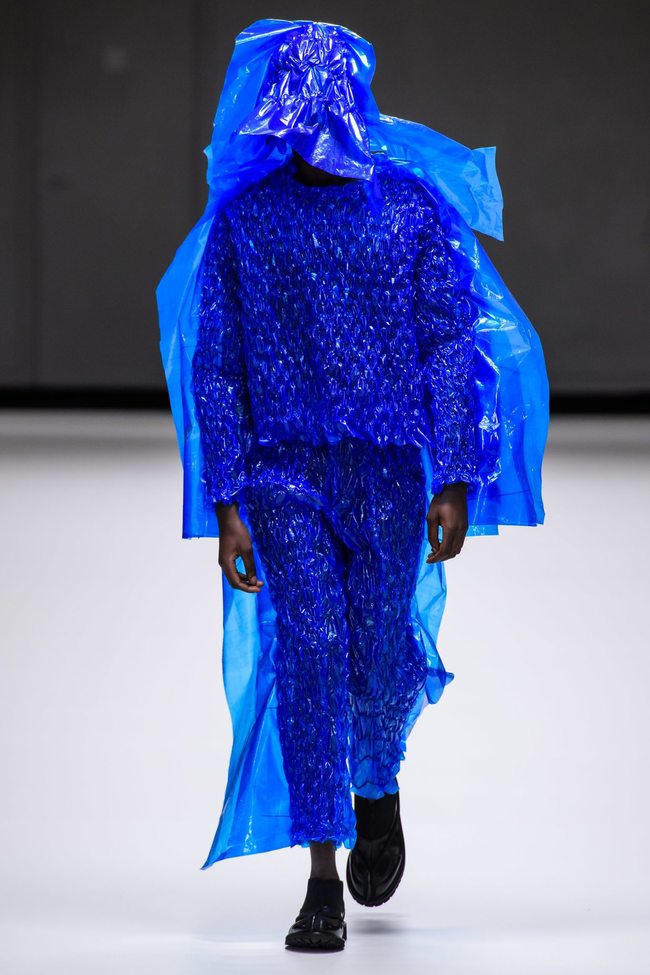
Craig Green: nomadismo alla moda con un tocco chirurgico
Di Godfrey Deeny
Craig Green è il sommo sacerdote del nomadismo nella moda. Potrà non aver inventato questa categoria, ma facendo tutto da solo è riuscito a renderla molto sua.
In ogni show che realizza, il cast sembra trovarsi in una sorta di viaggio. E questo è sembrato ancor più vero in un umido lunedì mattina londinese, nella sfilata di una collezione che è riuscita a collegare sartoria, abbigliamento sportivo e vestiti chirurgici.
Ambientato nelle viscere di The Vault, un seminterrato in mattoni nel vecchio Billingsgate Market sulla riva del Tamigi, il défilé ha anche ricordato quanto Green attualmente sia, e di gran lunga, il più creativo stilista di moda maschile di Londra.
Il suo momento migliore è stato il quintetto finale di enormi cappotti con cappuccio in tessuti tecnici. Le loro parti anteriori erano monocromatiche, mentre le posteriori mostravano paesaggi astratti e collage culturali in bordeaux brillante o nel blu delle ceramiche di Delft.
Idee chirurgiche sì, ma anche maniacali, come le camicie di forza multistrisce in un materiale che sembrava il washi, la carta usata per fare i muri nelle case tradizionali giapponesi. Detto questo, i suoi caban plaid multitasche per l’uomo erano un po’ assurdi, ma in qualche modo riuscivano anch’essi a portare ulteriormente avanti lo zeitgeist stilistico del designer. Il tutto mentre capisci già che le combinazioni semi-trasparenti di nylon vedo-non-vedo e maglie leggere di Green saranno copiate in tutte le high streets globali.
Craig Green – Autunno-Inverno 2019 – Londra
La sua idea più esagerata è stata un involucro elastico in plastica a forma di bolla tagliato in combinazioni comprendenti tunica e pantaloni, realizzate in tonalità neon sporche.
“Stavo pensando a un uomo fatto di vetro. Alla fragilità che significa anche forza. A tradizione, artigianato, tecniche tessili medievali e forse, come qualcuno ha detto, al ‘Piccolo Chirurgo’”, ha sorriso il designer, riferendosi al gioco di destrezza per bambini.
In un’epoca di monotona athleisure, Green è capace di rinfrescare con i ‘gusti’ che inventa i palati più esigenti della moda del Regno Unito. Accompagnato da una brillante colonna sonora mixata dal famoso DJ francese Frédéric Sanchez, e indossato da un cast che ha palesemente apprezzato l’avanguardismo di questi vestiti, lo show ha garantito a Green il più ampio e caloroso applauso della stagione maschile di tre giorni della London Fashion Week di gennaio 2019. Lo ha meritato.
Business Of Fashion – January 7th, 2019
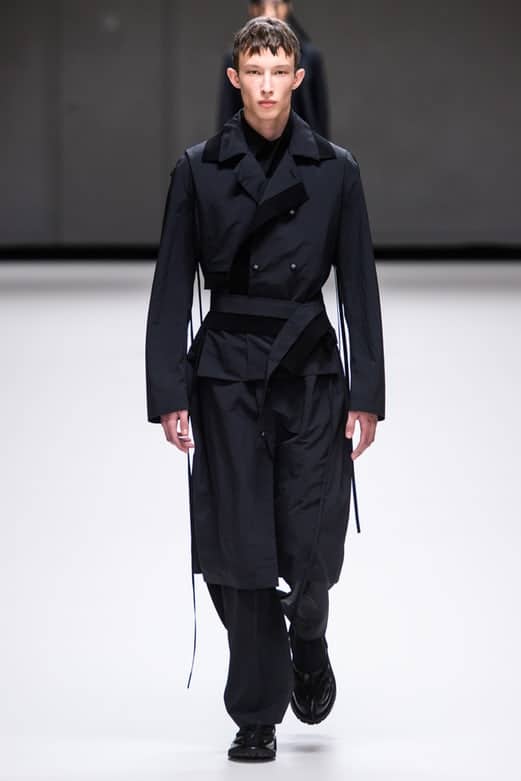
Craig Green Keeps It Real
The language the designer has created for himself is sturdy in its substance and oddly delicate in its effect. Today he outdid himself.
By Tim Blanks. LONDON, United Kingdom — A man made of glass: that was the extreme, sci-fi-ish image that lingered long after Craig Green’s remarkable show on Monday morning. Male fragility has been a Green theme from the beginning. At the same time, he’s always been committed to showing that emotion doesn’t mean weakness.
The designer’s latest show notes referred to “Fragile icons of symbolic strength.” His glass men were actually wrapped in “obsessively elasticated” plastic, with a bubble-wrap effect, “like fish or dragon scales,” said Green. He liked the notion of something that lasts forever reconfigured as ephemeral beauty.
It’s precisely that everlastingness which has made plastic the bane of modern times, but here it was alchemized into sweetness and light, like a dish of Venetian glass candies. (“A thing of beauty is a joy forever,” the poet John Keats once told us. That’s the kind of everlasting we can live with.)
Alchemy is Green’s secret weapon. He’s a past master of the magical transformation. His show opened with layered tailoring that had a chic new edge for him. The lining reversed so that when you turned a jacket inside it, you could wear it as a smock. Green’s signature utility made smart.
The finale was a sequence of hooded coats. From the front, the models were sober, monochrome samurai. Then they turned to reveal a glory of graphics. “Everything is so front-facing now,” he explained. “I like the idea you had to be at the show to see those images.” Keeping it real in the physical world, in other words.
Green’s work is thoroughly grounded in its physicality. This collection starred side-slit tartan caftans, tops and skirts in lumberjack checks, torsos wreathed in unravelling tapes of crochet (“a peeling cocoon,” he called it), more crochet and net sheathing bodies. This is the design language he has created for himself, sturdy in its substance, oddly delicate in its effect.
There was serenity too, in the pure white seersucker outfits that followed the exploding plastic inevitable on the catwalk. Green has already proved himself a consummate showman in the way he animates his dialogues between spirit and flesh. Here, he outdid himself, with the able assistance of stylist Robbie Spencer and soundtrackist Fred Sanchez. We could all wish for someone who would score our own lives with a mix of such epic, emotional sweep.
Craig Green Fall-Winter 2019-20

.
Marni Men’s Fall-Winter 2019-20

.
Berluti Fall-Winter 2019-20

.
Anna Sui Fall-Winter 2019-20

.
Simone Rocha Fall-Winter 2019-20

.
ERDEM Fall-Winter 2019-20

.
Prada Women’s Fall-Winter 2019-20

.
Nina Ricci Fall-Winter 2019-20

.
Hermes Women’s Fall-Winter 2019-20

.
Lacoste Women’s Fall-Winter 2019-20

.
Nina Ricci Fall-Winter 2019-2020 Women’s fashion show – Original music for the video.
Lacoste Fall-Winter 2019-2020 Women’s fashion show – Original music for the video.
Shiatzy Chen Fall-Winter 2019-2020 Women’s fashion show – Original music for the video.
Versace Fall-Winter 2019-2020 Women’s fashion show – Original music for the video
Marni Fall-Winter 2019-2020 Women’s fashion show – Original music for the video.
